Henry Chadwick Award: Richard Malatzky
This article was written by John Thorn
This article was published in Spring 2025 Baseball Research Journal
 In the early days of SABR, many of its most skilled researchers concerned themselves not only with the relative merits of men who played in different eras, but with determining who the players were. Hundreds of men were absolute ciphers, about whom nothing but a last name was known. This sort of digging seldom yields a full-fledged article, but is vital to those who may write decades later. In SABR metrics of another sort, RICHARD MALATZKY (1956–2018), is a hero.
In the early days of SABR, many of its most skilled researchers concerned themselves not only with the relative merits of men who played in different eras, but with determining who the players were. Hundreds of men were absolute ciphers, about whom nothing but a last name was known. This sort of digging seldom yields a full-fledged article, but is vital to those who may write decades later. In SABR metrics of another sort, RICHARD MALATZKY (1956–2018), is a hero.
Who was Richard, and why are his written contributions so scant? While he may have contributed to a thousand articles, his byline appeared on none of them. Although his name rarely appeared in print except in an Acknowledgments section, that seemed to be perfectly all right with him. He was a self-contained individual, with personal enthusiasms he was happy to enjoy alone.
And yet, we all seek peer recognition for our efforts. The first book with his name on the cover (alongside those of other editors) was Base Ball Pioneers, 1850–1870: The Clubs and Players Who Spread the Sport Nationwide. It won a Sporting News-SABR Baseball Research Award in 2013. He was buried with a copy of it.
Richard was perhaps the perfect candidate for a Chadwick Award, in the very way that the creators of the award intended. The criteria for the Chaddie, unchanged since origination, read in part: “The contributions of nominees must have had public impact. This may be demonstrated by publication of research in any of a variety of formats: books, magazine articles, websites, etc. The compilation of a significant database or archive that has facilitated the published research of others will also be considered in the realm of public impact.”
What is it that he did? Let him tell you.
As is my habit, I was checking another 19th century one-gamer, this time Harry C. Stine, listed for July 22, 1890 with the Philadelphia Athletics. I was surprised that the box score had the spelling as Stein. A search of Sporting Life said that Stein was a lefthanded pitcher from the Interstate League. It turned out that Baseball Reference had a Stein, no first name, who pitched for Dover and Wilmington, both of Delaware. This turned out to be our man. He appeared in box scores in 1889 and 1890 and when he was signed by Dover it was said that he played near Trenton in 1888.
So that was 2010 and the listing eliminated Harry C. Stine and replaced him with Stein, no first name…. The Philadelphia Times said he came from the Lebanon, Pennsylvania, team. A search came up with his signing with Lebanon and it said he had been with Wilmington. His name is William Stein. So we finally had his first name…. I checked the Philadelphia City Directory for William Stein and found five of them, including a…William H. who was born in Pennsylvania in April 1868 and two other Williams born in 1870 and 1872.
I searched the census for our man born 1867 to 1869. He turns up in Plattsburgh, New York, in the 1940 census with his daughter Isabelle Fisk and son in law Morgan Burleigh Fisk…. Our man’s wife Anna died in 1933, with her husband listed as William H. Stein, and was buried in Philadelphia’s Holy Redeemer Cemetery. William Henry Stein, it turns out, was born on April 9, 1868 in Telford, PA and died November 11, 1945 in Philadelphia. He is buried with his wife.
Those of us who have engaged in genealogical research can only stand in awe.
What do other distinguished researchers, all of them previous Chadwick Award winners, have to say about him?
- Peter Morris: “We worked on so many projects together that more than twenty years ago, Scott Flatow dubbed Richard and I the ‘M & M Boys.’ It meant a great deal to me to have my name placed alongside Richard’s, because he was one of a kind. When I started the Pioneer Project several years ago, Richard also cheerfully volunteered to help out and he was a major contributor to the two books that resulted.”
- Bill Carle: Richard Malatzky was one of SABR’s finest and most diligent researchers…relentless in his pursuit of missing players, often traveling to various cities on the east coast to visit libraries and look for clues. Richard was never satisfied that the data given for a ballplayer was [sic]) correct. He would always first verify that information, and if it was shown to be questionable, he would often start from scratch with the research. He would also look for alternate spellings of the player’s name, or variations on the city.”
- John Thorn: “Richard was just the sort of guy I like, one who cares deeply, even obsessively, about getting things right. Not only did he dispel mysteries of very long standing that had stumped others for decades, he corrected some of the “compromise” errors made in earlier record books whereby, for example, two fairly inconsequential players with the same common last name (Smith, Jones, Miller, etc.) had their records mistakenly grouped under one individual. His delights may well have seemed strange to the world, at large, but in shunning the noise of that larger world to visit an alternative one in the past, he and I and thousands of SABR members—too many of them, like Richard, departed—were brothers under the skin.”
I knew Richard by his work, and we spoke excitedly about his progress with new finds when we met at SABR conventions. But others, especially those in the Biographical Research Committee, knew Richard far better, and far longer. Clearly he was indispensable.
JOHN THORN is the official historian of Major League Baseball and the author of many books and essays.


